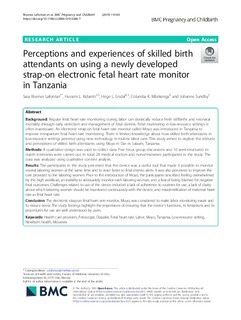| dc.contributor.author | Rivenes Lafontan, Sara | |
| dc.contributor.author | Kidanto, Hussein | |
| dc.contributor.author | Ersdal, Hege Langli | |
| dc.contributor.author | Mbekenga, Columba K. | |
| dc.contributor.author | Sundby, Johanne | |
| dc.coverage.spatial | Tanzania | nb_NO |
| dc.date.accessioned | 2020-02-10T13:26:53Z | |
| dc.date.available | 2020-02-10T13:26:53Z | |
| dc.date.created | 2019-08-16T13:16:58Z | |
| dc.date.issued | 2019-05 | |
| dc.identifier.citation | Lafontan, S.R., Kidanto, H.L., Ersdal, H.L. et al. (2019) Perceptions and experiences of skilled birth attendants on using a newly developed strap-on electronic fetal heart rate monitor in Tanzania. BMC Pregnancy and Childbirth, 19, pp. 1-10. | nb_NO |
| dc.identifier.issn | 1471-2393 | |
| dc.identifier.uri | http://hdl.handle.net/11250/2640786 | |
| dc.description.abstract | Background
Regular fetal heart rate monitoring during labor can drastically reduce fresh stillbirths and neonatal mortality through early detection and management of fetal distress. Fetal monitoring in low-resource settings is often inadequate. An electronic strap-on fetal heart rate monitor called Moyo was introduced in Tanzania to improve intrapartum fetal heart rate monitoring. There is limited knowledge about how skilled birth attendants in low-resource settings perceive using new technology in routine labor care. This study aimed to explore the attitude and perceptions of skilled birth attendants using Moyo in Dar es Salaam, Tanzania.
Methods
A qualitative design was used to collect data. Five focus group discussions and 10 semi-structured in-depth interviews were carried out. In total, 28 medical doctors and nurse/midwives participated in the study. The data was analyzed using qualitative content analysis.
Results
The participants in the study perceived that the device was a useful tool that made it possible to monitor several laboring women at the same time and to react faster to fetal distress alerts. It was also perceived to improve the care provided to the laboring women. Prior to the introduction of Moyo, the participants described feeling overwhelmed by the high workload, an inability to adequately monitor each laboring woman, and a fear of being blamed for negative fetal outcomes. Challenges related to use of the device included a lack of adherence to routines for use, a lack of clarity about which laboring women should be monitored continuously with the device, and misidentification of maternal heart rate as fetal heart rate.
Conclusion
The electronic strap-on fetal heart rate monitor, Moyo, was considered to make labor monitoring easier and to reduce stress. The study findings highlight the importance of ensuring that the device’s functions, its limitations and its procedures for use are well understood by users. | nb_NO |
| dc.language.iso | eng | nb_NO |
| dc.publisher | BioMed Central | nb_NO |
| dc.rights | Navngivelse 4.0 Internasjonal | * |
| dc.rights.uri | http://creativecommons.org/licenses/by/4.0/deed.no | * |
| dc.subject | fødsel | nb_NO |
| dc.subject | fetal heart rate monitoring | nb_NO |
| dc.title | Perceptions and experiences of skilled birth attendants on using a newly developed strap-on electronic fetal heart rate monitor in Tanzania | nb_NO |
| dc.type | Journal article | nb_NO |
| dc.type | Peer reviewed | nb_NO |
| dc.description.version | publishedVersion | nb_NO |
| dc.rights.holder | © The Author(s). 2019 | nb_NO |
| dc.subject.nsi | VDP::Medical disciplines: 700::Clinical medical disciplines: 750::Gynecology and obstetrics: 756 | nb_NO |
| dc.source.pagenumber | 1-10 | nb_NO |
| dc.source.volume | 19:165 | nb_NO |
| dc.source.journal | BMC Pregnancy and Childbirth | nb_NO |
| dc.identifier.doi | 10.1186/s12884-019-2286-7 | |
| dc.identifier.cristin | 1716452 | |
| cristin.unitcode | 217,13,2,0 | |
| cristin.unitname | Avdeling for kvalitet og helseteknologi | |
| cristin.ispublished | true | |
| cristin.fulltext | original | |
| cristin.qualitycode | 1 | |

